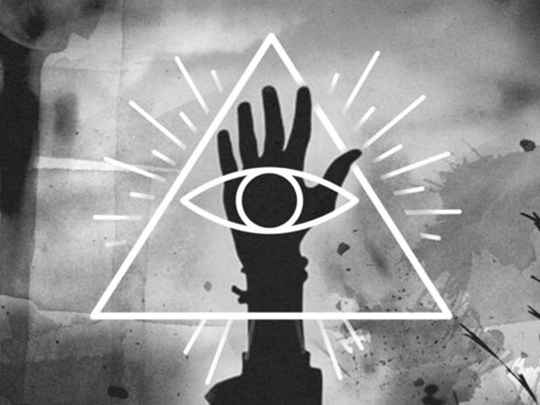
If he jumped off a building, would you take a leap too?
The usual answer, when the question is posed, is a giggle and a headshake. But when the search for identity leads you to the precipice of blind faith, there is little choice but to prepare for a tumble. No need to think, just a desperation to act.
Two grim reminders from India of what happens when you close your eyes to the world and listen to the curated arguments of one leader have of late shocked worldwide. One, when a family of six were found hung or flung out of a window. The other, a mass suicide by 11 members of a family – the motive, evidence suggests, was an ill-conceived grab at salvation.
These fatalities have all the makings of an imploding cult. In the case of the Burari family a son assumed authority, claimed favour of a spiritual guide (his late father) and manipulated his family members to death. In the Jharkand tale, there was an allusion to bankruptcy, which ended in deaths including of two minors.
And so we look at what a cult really is and why if you see someone struggling with one, it’s best to take action.
What is a cult, a gang, a mob?
A mob, on the other hand, is a collection of people who are disorderly, aggressive and triggered into a course of violent action. Remember when a group of indignant Indonesians decided to kill 292 crocodiles?
Or when spurned on by WhatsApp rumours mobs lynched and killed scores in India?
A gang, while on the surface resembles a cult, has a base level difference. Gangs are together for material gain; cults for personal benefit, says Dr Fabian Saarloos, Clinical Psychologist at German Neurological Centre.
What plays a role in all three cases is conditioning.
What is conditioning?
Growing up is like walking on pebbles across a pond; a learned behaviour; splashes of discomfort when you miss a foothold and a sense of achievement when you make it across.
It’s conditioning – a learnt response to a particular stimuli or trigger.
But it’s also a technique, explains Dr Jihene, that can be used for nefarious purposes. “So conditioning can play a role in building cults or building mobs; it’s like a neutral process and it can be used to [influence one into] bad [decisions]”.
In terms of cultish behaviour, initiation may include physical isolation, sleep deprivation, loss of privacy, constant playing of witness of a group. “You will find some collective hallucination, body manipulation, psychological games,” says Dr Jihene. Plus there are loyalty tests. It all works towards seeping free will and tapping primal fears.
Why would a person be drawn into a cult?
Society is built on a need to belong; to a group, to a people, to a cause. Mangled beliefs that can sew the rifts between existential crises therefore have a charm. “Vulnerable people, in say developmental stage [like] adolescence. Because they are unstable they are looking to build an identity, they are looking for someone to support them” and this may lead them to trust the tout.
Other people who are facing emotional turmoil such as divorce, serious illnesses, substance abuse problems, cash concerns, basically anyone with impaired judgement is a person at risk.
Elements of a cult
Dr Jihene explains the funnel of information that binds the groups. A cult leader, she explains, has monopoly over the belief set. The communication its members have is severely stifled. Here are some other telling signs.
- Mystical manipulation. In a cult the leader will use his own interpretation of events and history in a way that’s convenient for him.
- Demand of purity. The cult will talk about society as rift-ridden environment whose residents need to be purified. “Here the desire to become physically and mentally pure in the member of the cult will make them susceptible to guilt, fear, and moral [issues],” says the doctor.
- The rules of a cult are very, very extreme. Often their actions are against societal law; for instance, they may believe in condemning and being violent against another group. And all the answers to any questions remain with the leader. Only [he] has the privilege to know [the] absolute truth.
- Cult of confessions. Members must confess any wrongdoing to the leader including mental infraction which will increase somehow his power over them. The group that’s attracted the most flak – or at least publicity for such rules is author L Ron Hubbard’s church of Scientology. (For a list of stars you didn’t know were Scientologists, click here.)
- In a cult, the group’s doctrine takes the place over the individual’s. There is a marked change in priorities, loss of identity and personal will.
Be worried…if you see:
- Unquestioning loyalty to one person.
- Elitist tendencies and, trying to get others to join the group/cult
- People speak in a polarising way: us and them. Outsiders are evil
- The stern thought that the end justifies the means.
- A pattern of Isolation. A person may speak only with the people in the group.
How can you snap someone out of it?
It’s a very, very tough job. But not impossible. Dr Jihene explains that sometimes Stockholm syndrome-type behaviour may mean the physical forcing of a person away from the group. “Sometimes we have to wait till the person has some [health] problems so we can intervene and oblige them to have therapy.”
It refers to the feelings of trust or affection that a victim may feel towards a perpetrator of a crime. It is a coping mechanism when confronted with unsafe situations.
Education is key to reform. “[The] debriefing method will include educating the cult member on self-reform technique and help him to recognise those methods in his own cult’s experience, says Dr Jihene.
Showing the person he/she has a choice and identity is key. “Of course you will introduce also an emotional connection with his earlier life; friend, family, etc., sharing memories together that will destroy the polarising thought process,” she says.
But it is important that when treating the issue, one analyse the vulnerability that led this person to the cult – strained relationships, a lack of bonds, etc.
What does it have to do with mass suicides?
“When it comes to mass suicide, we have to look at the individual. Usually, they have low self-esteem and very susceptible to group influence. Generally they have some underlying psychopathology, depression, which may have been fuelled by the group as well,” says Dr Saarloos.
Cultish behaviour seems to fit. Plus there may be spiritual or emotional blackmail, as in the case of the Burari family where the son manipulated his family's belief system.
OSHO
Indian mystic man Osho, who had his books translated into more than 60 languages, still boasts a large following decades after his death in 1990. But before Bhagwan Shree Rajneesh was Osho, he was the leader of a cult that had moved from India to America. In Oregon in the 1980s, his followers built Rajneeshpuram, a mini town of devotees, complete with a giant dam, an airport, an electricity station and a meditation centre. The story of the group is the fodder of Wild Wild Country – a documentary that witnesses accounts by former cult members and their once-neighbours in Oregon.
AUM SHINRIKYO
Aum Shinrikyo The Aum Shinrikyo is arguably the most notorious of Japan’s cults. Its members launched a nerve gas, sarin, attack during morning rush hour in a Tokyo subway before taking antidotes and escaping. The episode ended in the death of 12 people and the hospitalization of 5,500, most of whom suffered long-lasting damage to their eyes, lungs and digestive systems. Japan’s police raided the cult’s headquarters and arrested many members and the leader Shoko Asahara, who was executed earlier this month.
The cult combined Buddhism and yoga with apocalyptic Christian philosophy. In the years since the 1995 attack, five Aum members have been sentenced to death.
THE FAMILY
The Family It may have been non-religious but in no way was this the perfect happy unit. In 1967, in San Francisco, the Manson family formed a cult that weaved together beliefs partly from Scientology, partly from Satanism. Touting and to spark a race war, the members of this family ordered killings in the nearby area; African-Americans were to be made scape goats. Nine people were murdered, including coffee heiress Abigail Folger and director Roman Polanski’s wife, actress Sharon Tate. The leader was convicted and sentenced to death; he wasn’t executed; he spent life in jail.












